| Organization Name | Target Activities | Grant Amount |
|---|---|---|
| EXPLORE GAIA ENTERPRISE | Improvement of nesting opportunities for endangered hornbills | 2,000 thousand yen |
| Wildlife Science Conservation Center of Mongolia | Spreading awareness for the conservation of rare bird breeding sites | 2,000 thousand yen |
| Royal Society for Protection of Nature, Bhutan | Establishment of captive breeding techniques for the endangered white-bellied heron in the Kingdom of Bhutan | 2,000 thousand yen |
| Marine Bird Restoration Group | Aiming to establish a population estimation method for the Japanese Murrelet | 2,000 thousand yen |
| Toyohashi Zoo and Botanical Park | Efforts to release artificially raised chicks into the wild | 2,000 thousand yen |
| (NPO) Amami Ornithologists’ Club | Surveying and researching the Amami woodcock , which inhabits the island’s World Natural Heritage Site (2nd year) | 2,000 thousand yen |
| (Foundation) Yamashina Institute for Ornithology | Identification of ocean areas that can be used for conservation of the endangered albatross | 2,000 thousand yen |
| Inter-Institutional Panel on the Management of Stork Populations (IPPM-OWS) | Survey of breeding status of storks at all breeding sites in Japan and development of a new stork conservation policy | 2,000 thousand yen |
| Japanese Association for Wild Geese Protection | Restoration of Cackling Geese flocks in the Nanakita lowlands (their historical wintering grounds) and public awareness activities | 2,000 thousand yen |
| Wild Bird Society of Japan, Saga Prefecture Chapter | Stork breeding support activities (continued) | 1,000 thousand yen |
| (NPO) Study of Sandankyo and the Ota River Watershed | Conservation activities to help ensure the future of the crested kingfisher | 800 thousand yen |
| Sapporo Maruyama Zoo | Establishment of rehabilitation techniques for protected individuals, etc. that are sick or injured | 700 thousand yen |
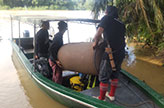
We are dedicated to conserving the tropical forests and biodiversity of the Kinabatangan River Basin on the island of Borneo. We are currently planning to improve the nesting environment of rhinoceros hornbills in the region by building and installing artificial nest boxes and restoring their natural tree hollow nests. We will fit the nest boxes and tree hollows with automatic cameras to capture behavioral data on the hornbills and any other animals that find their way into the nests. Our hope is that this data will be useful for future research and studies.
■Activity locations:Borneo, Malaysia
■Grant amount: 2,000 thousand yen
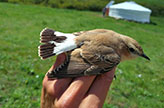
Our area of activity is a breeding ground for many species of wild birds, including the yellow-breasted bunting, white-naped crane, and great bustard. However, the few remaining willow forests along the region’s streams and rivers are disappearing due to livestock grazing pressure, and there have been cases of unleashed dogs eating white-naped crane chicks. For this reason, there is an urgent need to increase local awareness of these and other ecological problems. This is why our activities have expanded to providing nature conversation classes to local schoolchildren, and conducting field survey practice for university students.
■Activity locations:Khentii Province, Mongolia
■Grant amount: 2,000 thousand yen

The white-bellied heron is an endangered bird species that inhabits freshwater river ecosystems in the Himalayas. With only 24 individuals left alive in Bhutan, their survival is extremely critical. Our society will invite a Japanese captive breeding specialist to our ex situ conservation site in Bhutan and conduct outdoor hatching and captive breeding of the white-bellied heron. We also aim to achieve reliable captive breeding of the birds through training in Japan and to increase their population through captive-bred releases.
■Activity locations:Kingdom of Bhutan and Sado City, Niigata Prefecture
■Grant amount: 2,000 thousand yen
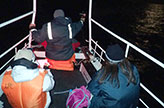
Spotlight surveys have become one of the tools used to determine the size of the Japanese murrelet population. However, a method has yet to be established for estimating the number of breeding individuals, which is the most important number in bird conservation. The procedures for spotlight surveys have largely remained unchanged since the method was first utilized in Japan in 2011. This year , we will investigate the application of correction factors used for murrelet population surveys overseas to the Japanese murrelet.
■Activity locations:Kojima and Biro Island in Otsuki Town, Hata District, Kochi Prefecture
■Grant amount: 2,000 thousand yen
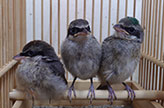
We are working to prevent the extinction of the Japanese shrike, a subspecies of brown shrike endemic to Japan that has experienced a drastic decline in population. Having largely established artificial hatching and hand-rearing techniques for abandoned eggs, we will continue our efforts to breed the birds in captivity, while also investigating the possibility of releasing captive-bred birds into the wild. As captive-bred birds need to training to adapt to outdoor environments before they can be released, we conducted this training inside the park on a trial basis. Due to the need to conduct such trials in a variety of environmental conditions, we are planning to develop temporary bird housing that can be assembled in the field.
■Activity locations:Toyohashi City, Aichi Prefecture and Nagano Prefecture
■Grant amount: 2,000 thousand yen
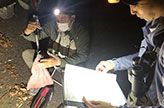
Our conservation activities are primarily concerned with bird species endemic to the Amami Islands. Amami Oshima, Tokunoshima, and other islands in the archipelago, are known to be breeding grounds of the Amami woodcock. However, there are also observational records showing that some individuals are wintering in Okinawa Island and neighboring islands. We intend to use our subsidy to identify any Amami woodcock breeding grounds that might exist on these islands where the birds have been spotted in the winter.
■Activity locations:Kagoshima Prefecture (Amami Islands), Okinawa Prefecture
■Grant amount: 2,000 thousand yen
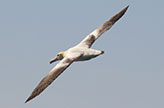
The short-tailed albatross, a threatened species, was previously considered to be a single population by conservationists. Recently, it has become clear that there are two distinct subpopulations nearly as different as two separate species. As such, there is an urgent need to consider conservation measures to preserve the uniqueness of each subpopulation. In this activity, we will employ GPS tracking to identify areas used by the birds outside of their breeding season and to track their movement around the year, using the results to examine marine threats to both populations, such as fishery bycatch and marine pollution.
■Activity locations:Hokkaido, Aomori Prefecture, Nagasaki Prefecture, etc.
■Grant amount: 2,000 thousand yen
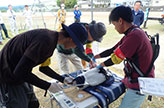
Since the first release of captive-bred individuals in 2005, storks have gradually expanded their breeding grounds throughout Japan, with nests confirmed in 12 prefectures by 2023. Our panel will continue the detailed monitoring the wild population. At the same time, we will develop a new stork conservation policy to guide our activities. In this way, we will promote comprehensive conservation activities both inside and outside the habitat area.
■Activity locations:All over Japan
■Grant amount: 2,000 thousand yen
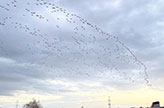
Flocks of wintering cackling geese were once a common sight in Japan, but their numbers drastically declined due local extinction levels to overhunting and other factors. Thanks to international cooperation between Japan, Russia, and the United States, however, the number of cackling geese that visit Japan has recovered to over 10,000. In 2022, we launched a project to bring flocks of cackling geese back to the Nanakita Lowlands (located between Sendai City and Tagajo City), which was previously one of their traditional wintering grounds. As part of this project, students from Sendai Ikuei Gakuen High School, which is located in Nanakita Lowlands, have led an effort to elucidate the birds’ distribution since the Edo Period. This was made possible by the support of industry, government, academic, and civic partners, as well as the involvement of local citizens and administrative agencies.
■Activity locations:Sendai City and Tagajo City in northern Miyagi Prefecture
■Grant amount: 2,000 thousand yen
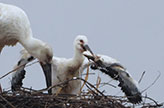
Our activities have been supported by this subsidy since 2023. In the two years since the first successful breeding of storks in Kyushu, three young storks have left the nest. Our efforts to build biotopes that can serve as reliable feeding grounds for the storks, keep some of the area’s lotus ponds flooded year-round, and install nesting towers are proceeding steadily. 2025 is the third year of our project, and will the year of its culmination. By expanding the local conservation associations, and further increasing local farmers’ understanding of the issue, we will make the Ariake Sea Coast into a place with multiple stork breeding grounds.
■Activity locations:Saga Prefecture Ariake Sea Coast
■Grant amount: 1,000 thousand yen
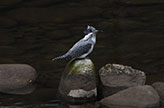
Through crested kingfisher conservation efforts with community involvement, we aim to maintain the rich ecosystem of our region. As the birds serve as an indicator species, we conducted surveys in FY2024 to determine their population numbers and habitat areas, and to monitor their breeding status. In FY2025, we will expand the scope of these surveys to cover a broader area, while also installing more artificial nesting holes and conducting a survey of local rivers. In addition, we will be providing schoolchildren with picture story shows about the ecology and parenting habits of crested kingfisher using materials produced by the local wild bird society.
■Activity locations:Area around Akiota Town, Yamagata District, Hiroshima Prefecture
■Grant amount: 800 thousand yen
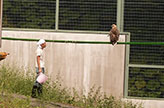
Established in 2010, the Maruyama Zoo Raptor Rehabilitation Center is working to establish captive breeding techniques for birds of prey and rehabilitate injured individuals using the techniques of falconry. In order to accumulate scientific knowledge, we fit the rehabilitated birds with transponders to track them after release. This allows us to confirm the effectiveness of our rehabilitation efforts and improve our techniques. We hope to contribute to the conservation of birds of prey by continuing to build our rehabilitation track record, accumulate tracking data, and improve our techniques.
■Activity locations:Hokkaido Prefecture
■Grant amount: 700 thousand yen
| Organization Name | Target Activities | Grant Amount |
|---|---|---|
| Lagoon Subcommittee , Shimin Committee | Observation of Fukushima Lagoon and coexistence with wild birds | 200 thousand yen |
| Swan Environment Protection Committee, Akatsuka Junior High School, Niigata City | Observation and care of swans | 200 thousand yen |
| Village of the Grey-faced Buzzard Association | Experience the home of the Grey-faced Buzzard! | 200 thousand yen |
| Organization Name | Target Activities | Grant Amount |
|---|---|---|
| (Foundation) Ecosystem Conservation Society-Japan | Project for dispersion of hooded cranes and white-naped cranes across their wintering grounds | 10,000 thousand yen |
| Japanese Society for Preservation of Birds (JSPB) | Project to support the reintroduction and establishment of the Japanese crested ibis in the wild on Honshu | 10,000 thousand yen |